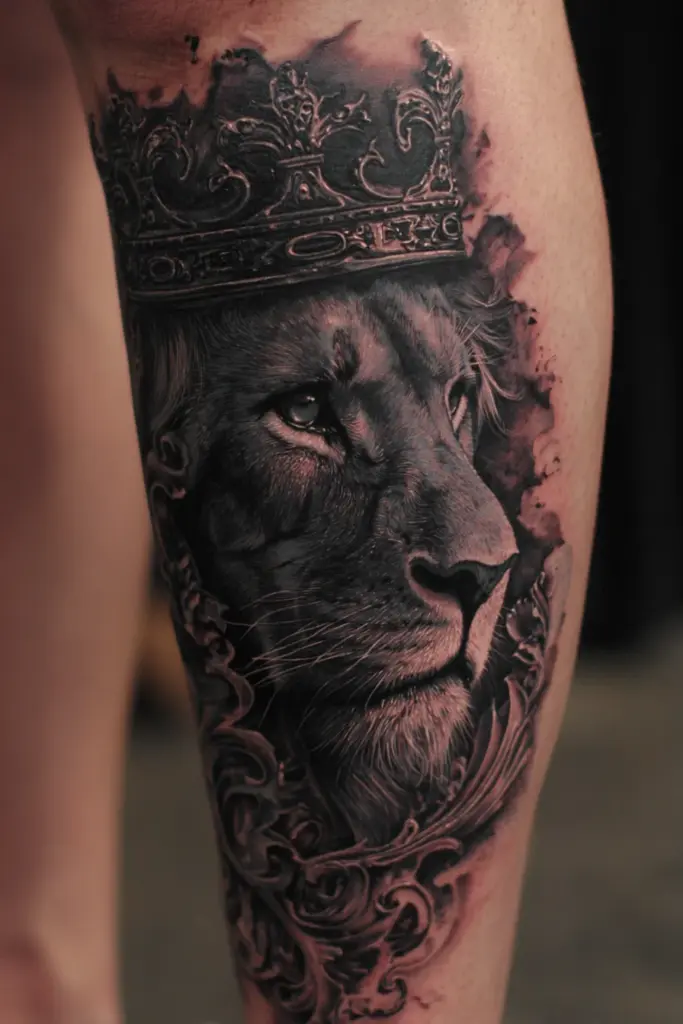Im Hakan, a tattoo consultant and designer with over a decade working in modern tattoo culture. In this post I share 11 curated men tattoo ideas illustrated with images and practical guidance, drawn from real client consultations and studio experience. These designs suit a range of men — first-timers seeking a subtle piece, professionals who need discreet placement, and seasoned collectors building sleeves or statement work. Each idea includes notes on style, placement, size, and meaning so you can quickly assess what fits your lifestyle and body. Practical tips cover choosing the right artist, matching designs to skin tone and anatomy, pain and healing expectations, and when to opt for color versus blackwork. Use these examples as starting points — adapt motifs, scale, and line weight with your artist to make a tattoo that’s personal, wearable, and built to age gracefully.
Black & Grey Realism Classical Statue Forearm Tattoo
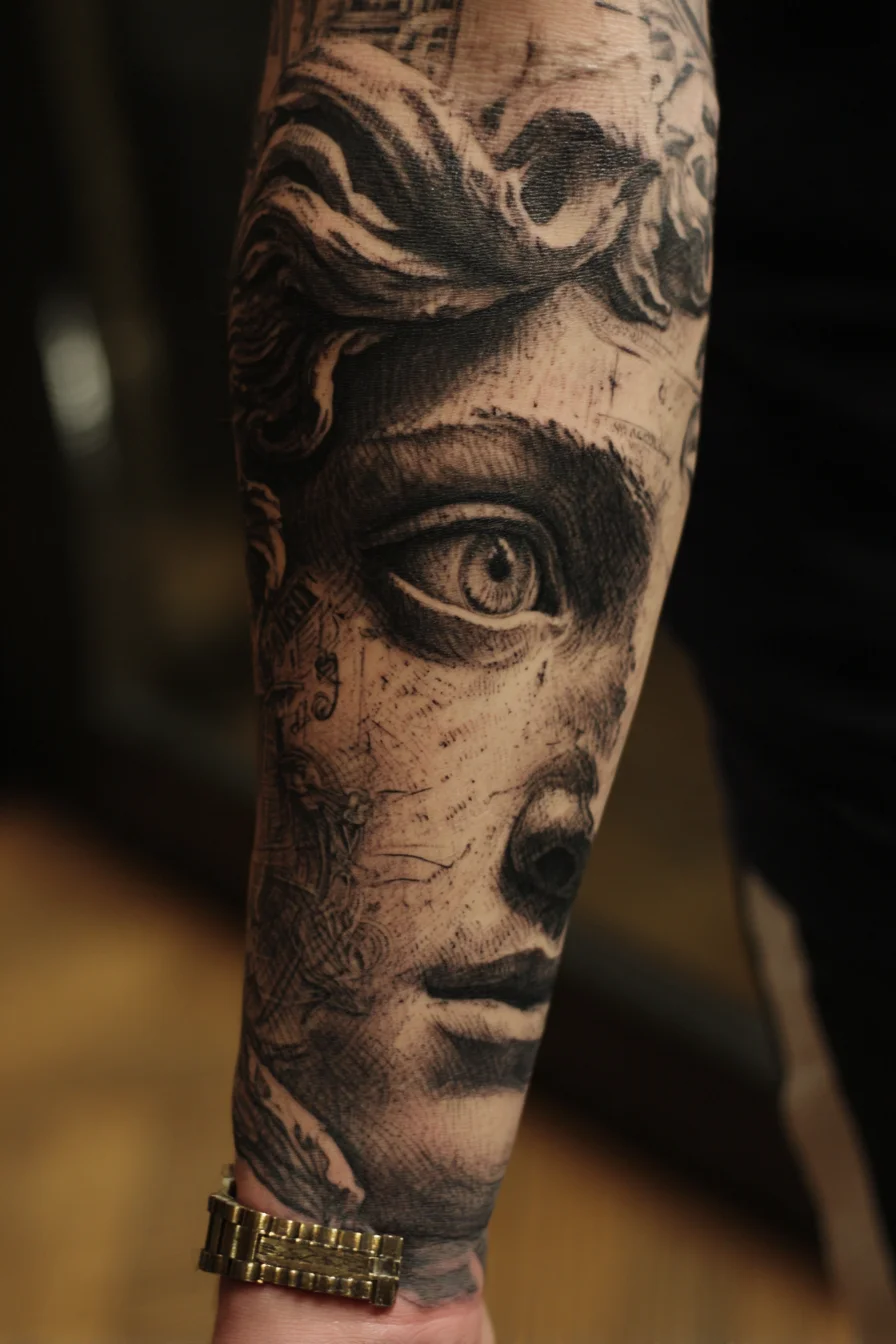
This black-and-grey realism portrait evokes classical sculpture — a design that conveys timelessness, stoicism and artistic appreciation. It reads best at a larger scale so the subtle cross-hatching, soft shading and weathered stone texture remain legible. Placement suggestions: outer or inner forearm for visibility and lower pain, full or half sleeve to integrate with existing pieces, or extended to chest/calf for a larger composition. Pain expectations: outer forearm is generally moderate and tolerable for most men; inner forearm, wrist and bony areas increase sensitivity. Expect multiple sessions for the detailed shading and texturing. Size considerations: aim for a minimum of roughly 6–8 inches height to keep facial features crisp — larger canvases allow finer detail and smoother gradients. Styling variations: stick with pure black-and-grey for a classical look, add dotwork or stippling for aged texture, incorporate subtle color accents (gold or sepia) for contrast, or frame the face with geometric shapes, floral elements, clocks or script to personalize meaning. Discuss session planning and aftercare with your artist to preserve detail and longevity.
Realistic King Portrait Forearm Tattoo with Compass — Masculine Nautical Design
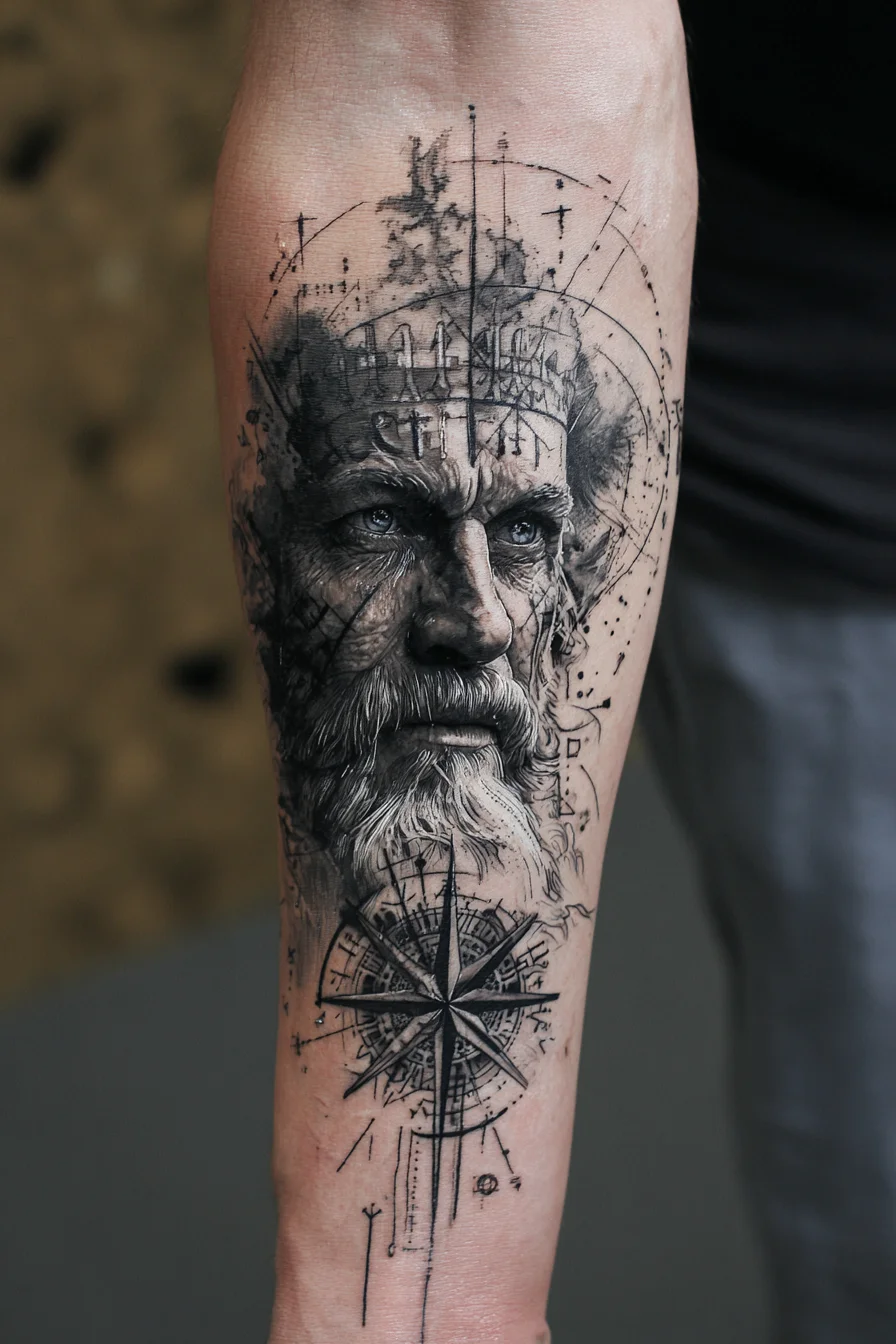
Bold, realistic portraiture of a crowned, bearded king paired with a detailed compass creates a masculine tattoo that symbolizes leadership, experience, resilience and a sense of direction. The crown and aged face read as wisdom and authority, while the compass anchors the piece in themes of navigation, purpose and life’s journey—a strong narrative for men seeking meaningful body art. Placement and sizing: ideal on the forearm (inner or outer) where the vertical layout complements the limb; it also transfers well to the upper arm, chest or calf. For true realism keep the portrait at least 6–8 inches (15–20 cm) tall so skin texture, eyes and hair hold fine detail; scale the compass to balance the composition. Pain and sessions: forearm work is generally moderate in discomfort—inner forearm, wrist or elbow areas are more sensitive. Expect multiple sessions for larger pieces and heavy shading. Styling variations: black-and-grey realism is most impactful, but add subtle color highlights (blue eyes, brass tones), sketch/ink-splatter overlays, or geometric/dotwork frames to personalize the design and integrate it into a sleeve.
Forearm Geometric Compass Tattoo — Minimal Linework Navigation Design
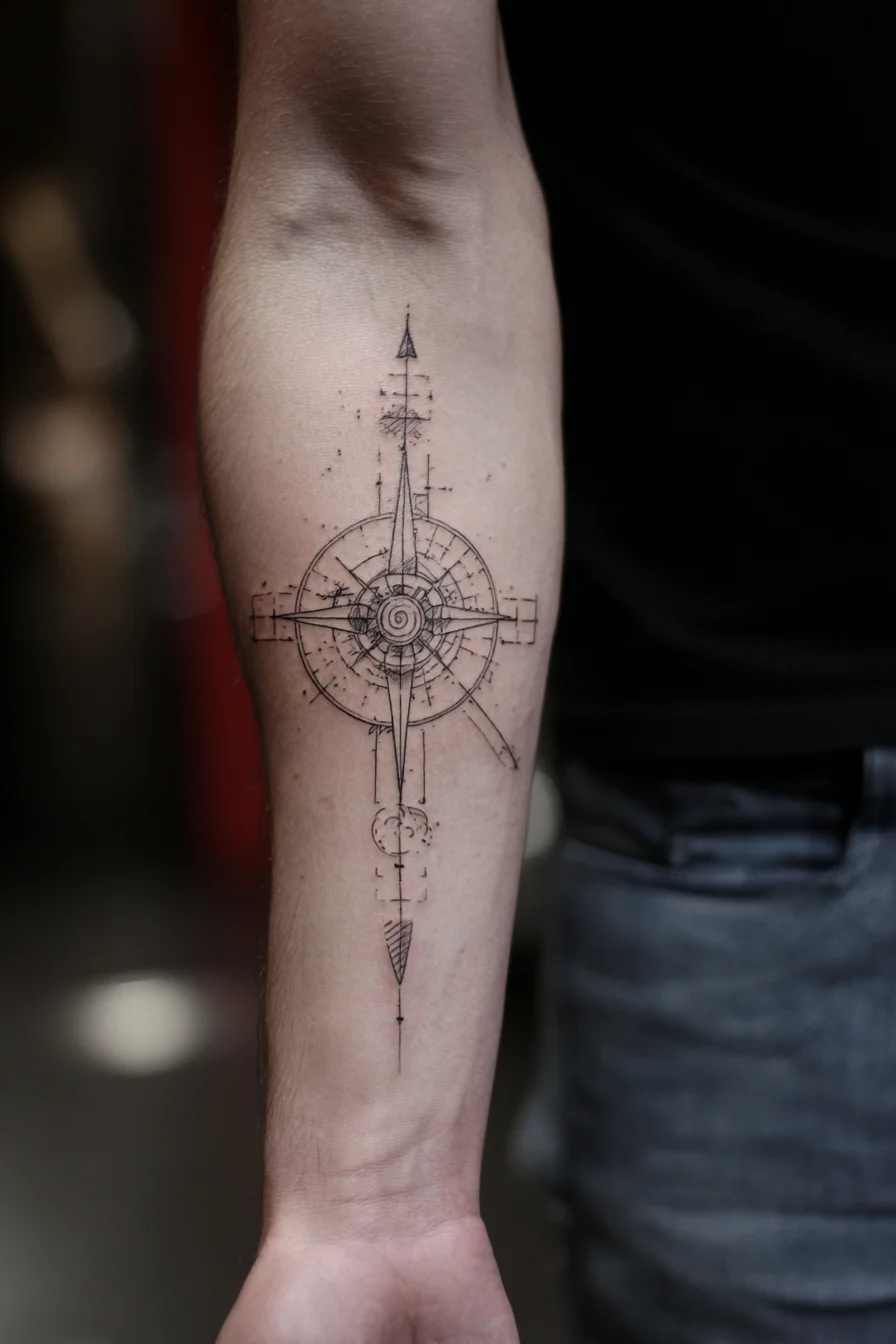
This tattoo combines a classic compass motif with fine architectural linework and a spiral center, symbolizing direction, personal journey, and a disciplined sense of purpose. Its geometric, technical aesthetic reads modern and masculine — ideal for men who want an emblem of guidance rather than ornate ornamentation. Placement suggestions: the inner or outer forearm shown here works especially well because the long vertical composition follows the arm’s natural lines and is easy to display or conceal with sleeves. Other good sites include the calf, ribs, or upper arm for larger scale. Pain expectations: forearm tattoos are typically low-to-moderate in discomfort; the inner forearm is a bit more sensitive, while areas near the wrist and elbow are noticeably sharper due to thinner skin and proximity to bone. Size considerations: to preserve the fine detail, plan for a medium size (roughly 3–6 inches / 7–15 cm); very small renditions may lose the delicate linework and require heavier lines. Styling variations: you can opt for bold blackwork for longevity, dotwork shading for texture, subtle color accents or watercolor washes for contrast, or incorporate coordinates, initials, or map elements to personalize the piece. Expect occasional touch-ups over years to keep thin lines crisp.
Realistic Black & Grey Lion Portrait — Forearm Masculine Tattoo
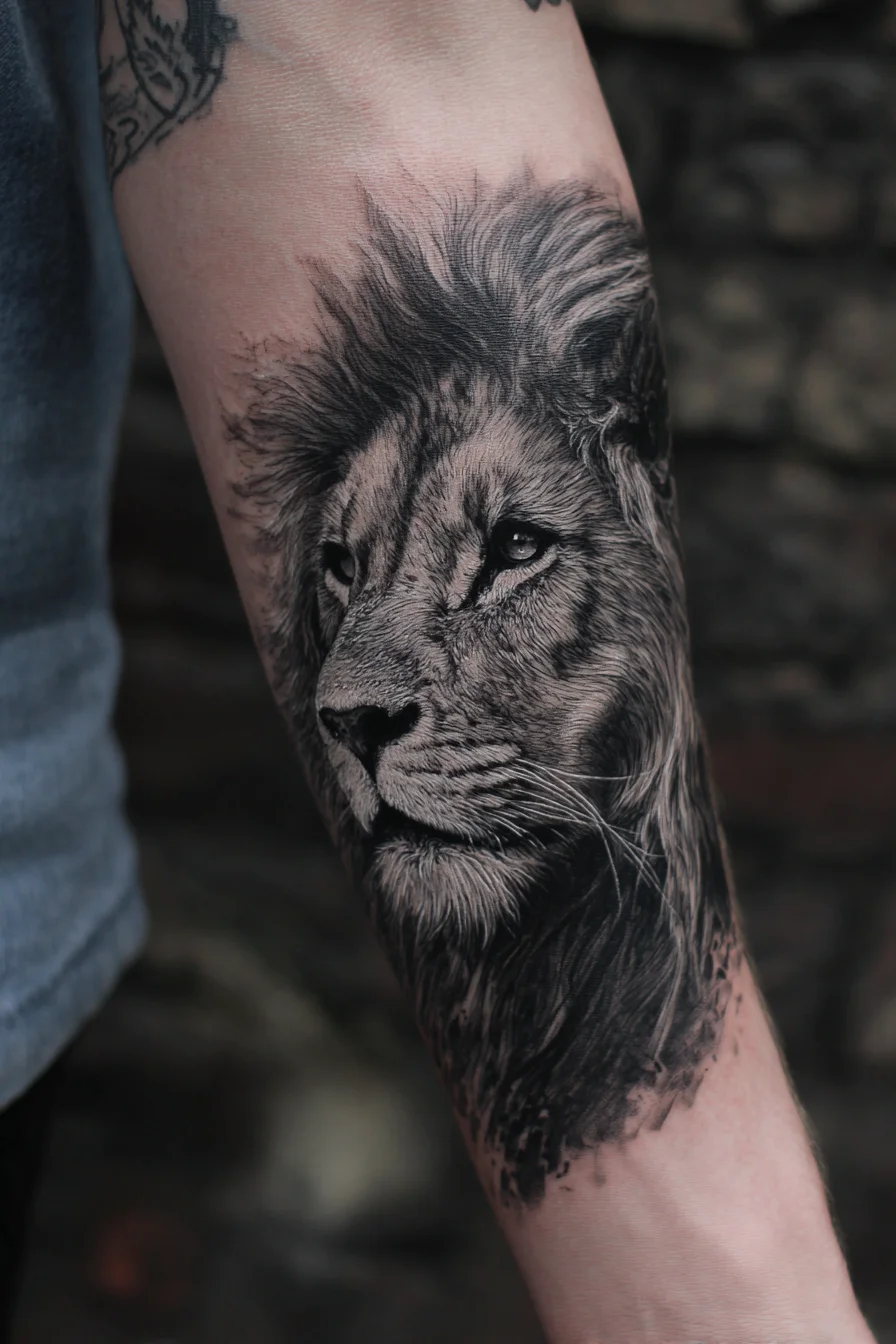
This black-and-grey realistic lion portrait is a bold, masculine piece symbolizing leadership, courage and protection. The high-detail fur texture and reflective eye work give it a lifelike presence that reads well from a distance and retains impact as it ages when executed by an experienced artist. Placement suggestions: the outer or inner forearm shown here is ideal for a vertically oriented portrait — it provides a long, relatively flat canvas and is easy to display or cover; alternatives include the upper arm, shoulder, chest or calf for larger compositions. Pain expectations: forearm work is generally moderate — outer forearm and fleshy areas are more tolerable, while the wrist, inner elbow and bony edges feel sharper. Size considerations: to preserve realistic detail plan for a medium-to-large piece (palm-sized to full forearm, roughly 6–12 inches depending on anatomy); smaller sizes will lose fine texture. Styling variations: keep classic black-and-grey realism, add subtle amber or gold eye highlights for contrast, or combine the portrait with geometric backgrounds, dotwork, or soft watercolor washes. Discuss aging, line density and touch-ups with your artist before booking.
Classical Bearded Portrait Forearm Tattoo — Sketch Realism & Linework
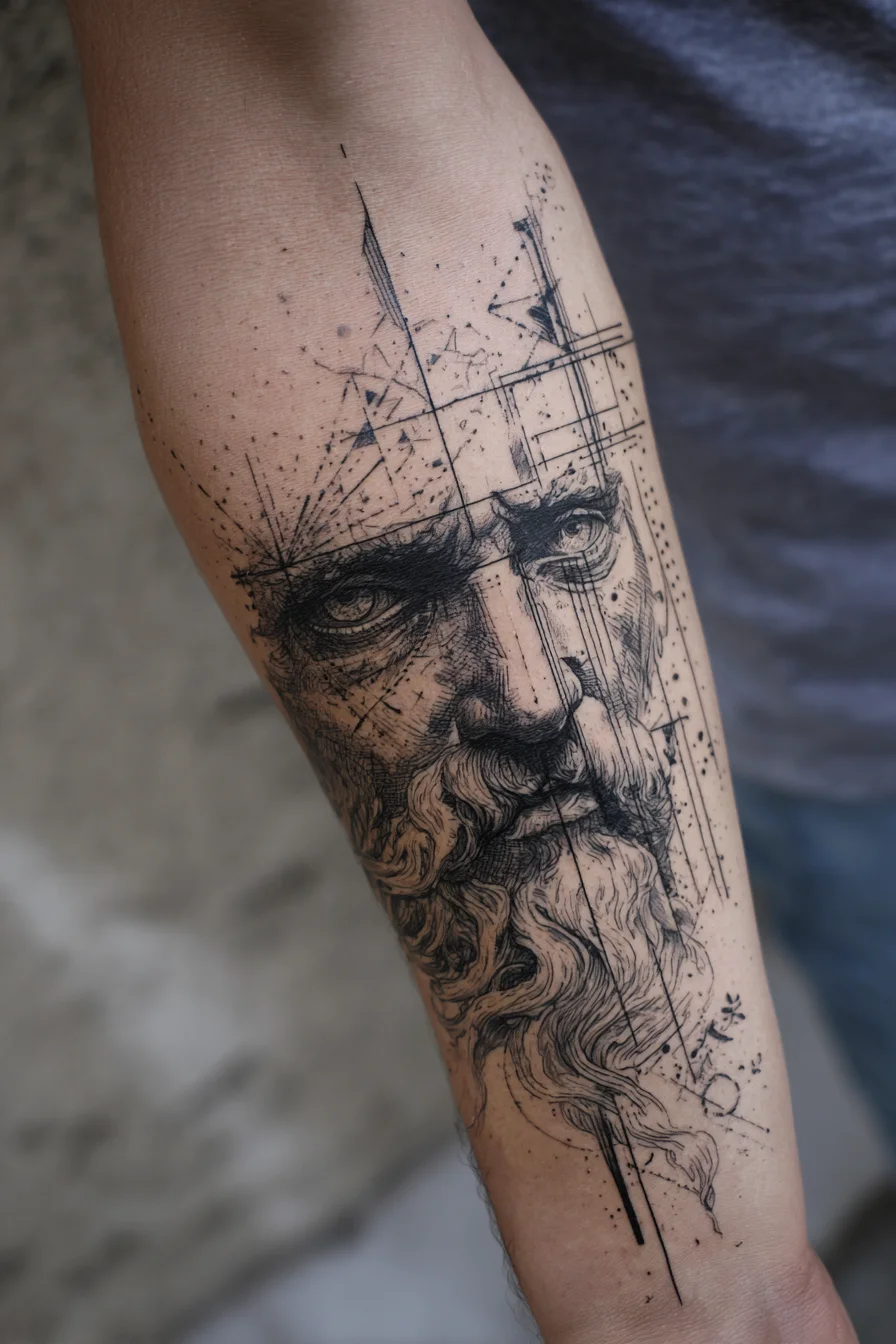
This design pairs a classical, bearded male portrait with sketch-style linework and geometric guides to create a look of timeless wisdom and controlled chaos. Conceptually it reads as resilience, introspection and disciplined creativity — ideal for men wanting a masculine, contemplative piece. Placement-wise the outer forearm shown is a top choice: it offers good visibility, flat skin for detailed work and generally moderate pain. Alternatives include upper arm, chest or calf if you want a larger canvas; avoid ribs or sternum unless you expect higher discomfort. Expect pain to range from low-moderate on the outer forearm to moderate-high in areas with thinner skin or closer to bone; dense beard shading and heavy blackwork increase session intensity. Size considerations: keep this piece at least 6–8 inches (15–20 cm) vertically to preserve facial detail and fine lines — smaller iterations should simplify texture. Styling variations include pure blackwork, dotwork/stippling, adding muted color washes, or expanding into a sleeve with geometric elements. Note: fine-line portraits need attentive aftercare and occasional touch-ups to maintain crispness over time.
Black & Grey Realistic Portrait Forearm Tattoo — Grunge Watercolor Style
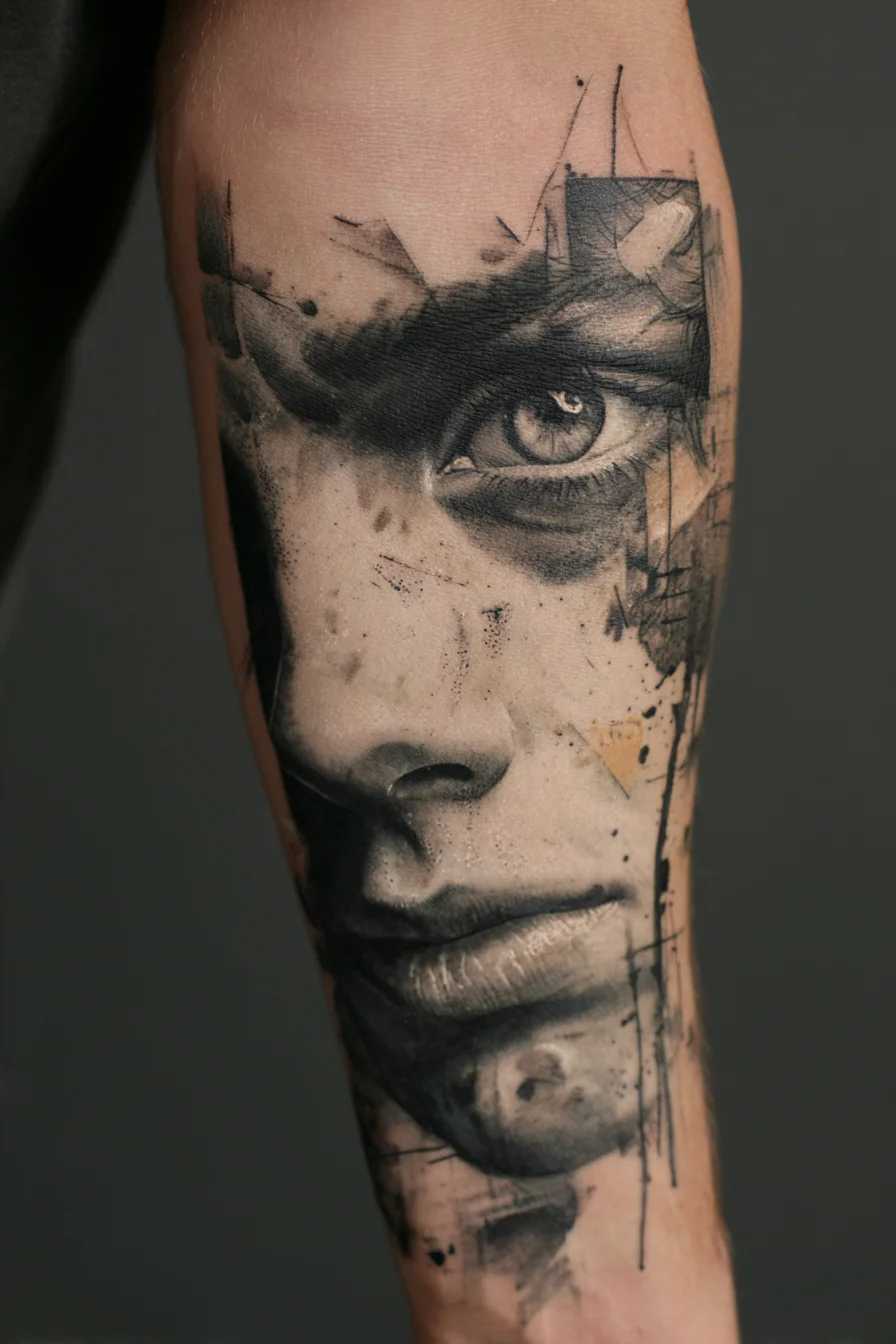
This striking black-and-grey portrait blends photorealism with grunge watercolor and sketch marks to create a moody, masculine statement piece. Meaning can be personal—memory, resilience, or the intensity of a gaze—while the distressed textures add an emotional, lived-in feel. Placement suggestions: outer or inner forearm for visibility and relatively manageable pain, or upper arm/chest and calf if you want a larger, more private canvas. Pain expectations: outer upper arm and outer forearm are generally low‑to‑moderate, inner forearm and chest run moderate, while ribs and sternum are high; expect longer sessions for fine facial details. Size considerations: to preserve realism and subtle tonal transitions, plan medium-to-large sizing (roughly 15–25 cm / 6–10 in tall); smaller scales will lose detail. Styling variations: keep pure black-and-grey for classic realism, add selective color accents (sepia or muted gold) for contrast, or incorporate geometric linework and dotwork to modernize the look. Consult a skilled portrait artist with portfolio samples, discuss session pacing, and consider topical numbing and aftercare to optimize comfort and healing.
Realistic Viking Warrior Portrait — Black & Grey Forearm Tattoo
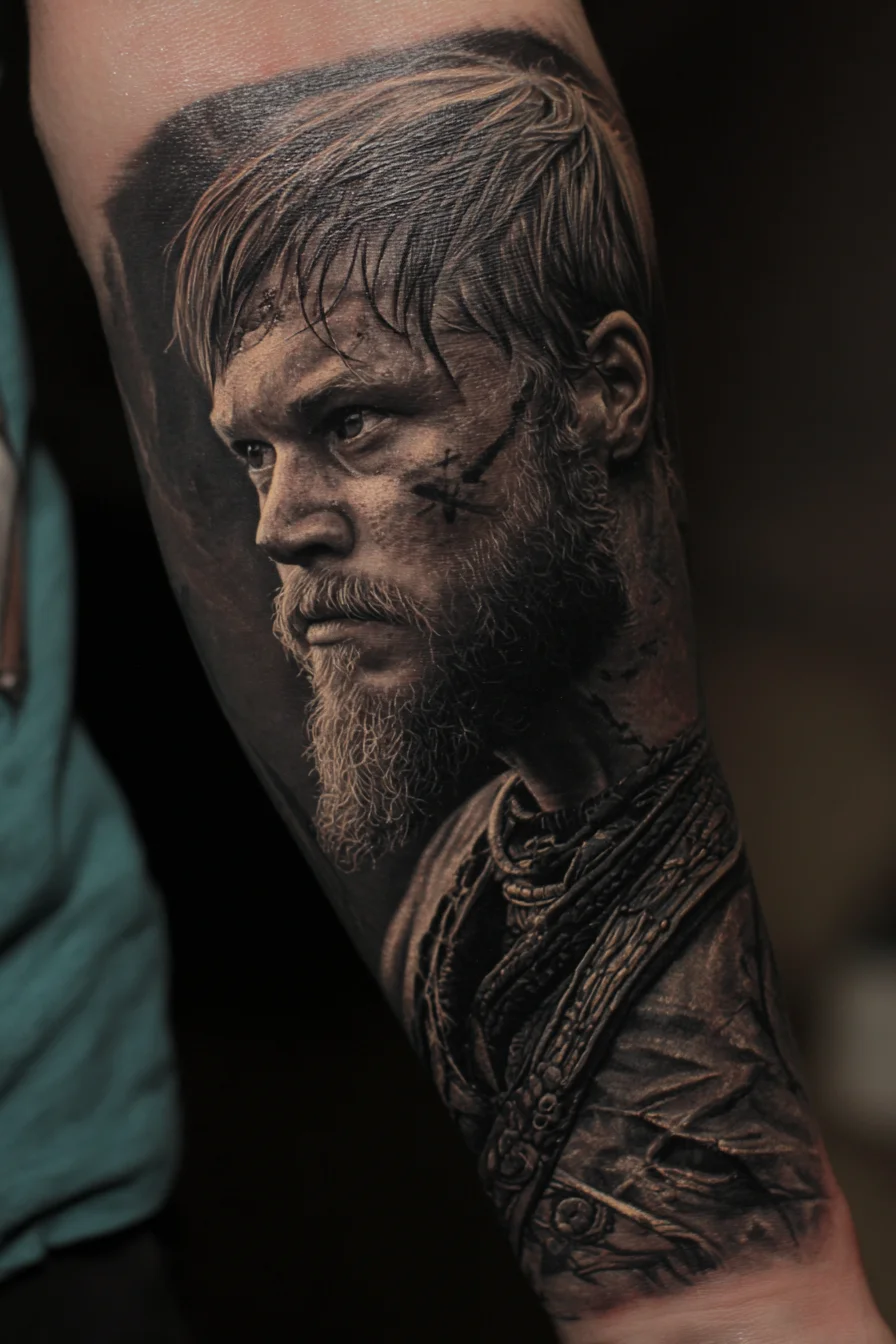
This hyper-realistic black-and-grey portrait captures a bearded warrior look — textured hair, facial scars and layered necklaces — designed to convey strength, resilience and ancestral or warrior ethos. For men seeking a bold, masculine statement, this style reads as both narrative and wearable art. Placement suggestions: outer forearm or full forearm sleeve to show profile detail; chest, upper arm or calf also work well for larger compositions. Pain expectations: outer forearm and upper arm are generally low-to-moderate in discomfort; inner forearm, ribs and near wrist/bone areas are more sensitive. Expect longer sessions for portrait shading and fine hairwork — plan 1–3 sessions depending on size and artist speed. Size considerations: to preserve facial detail, aim for a larger canvas (roughly 6–8 inches / 15–20 cm minimum height); full-sleeve scale improves realism and allows background work. Styling variations: pure black-and-grey realism, subtle sepia or muted color highlights, dotwork or textured backgrounds, geometric frames or Norse symbols integrated around the portrait. Choose a specialist in realistic portraiture and bring high-resolution references for best results.
Oni Mask Calf Tattoo with Rose — Black & Gray Japanese Demon Design
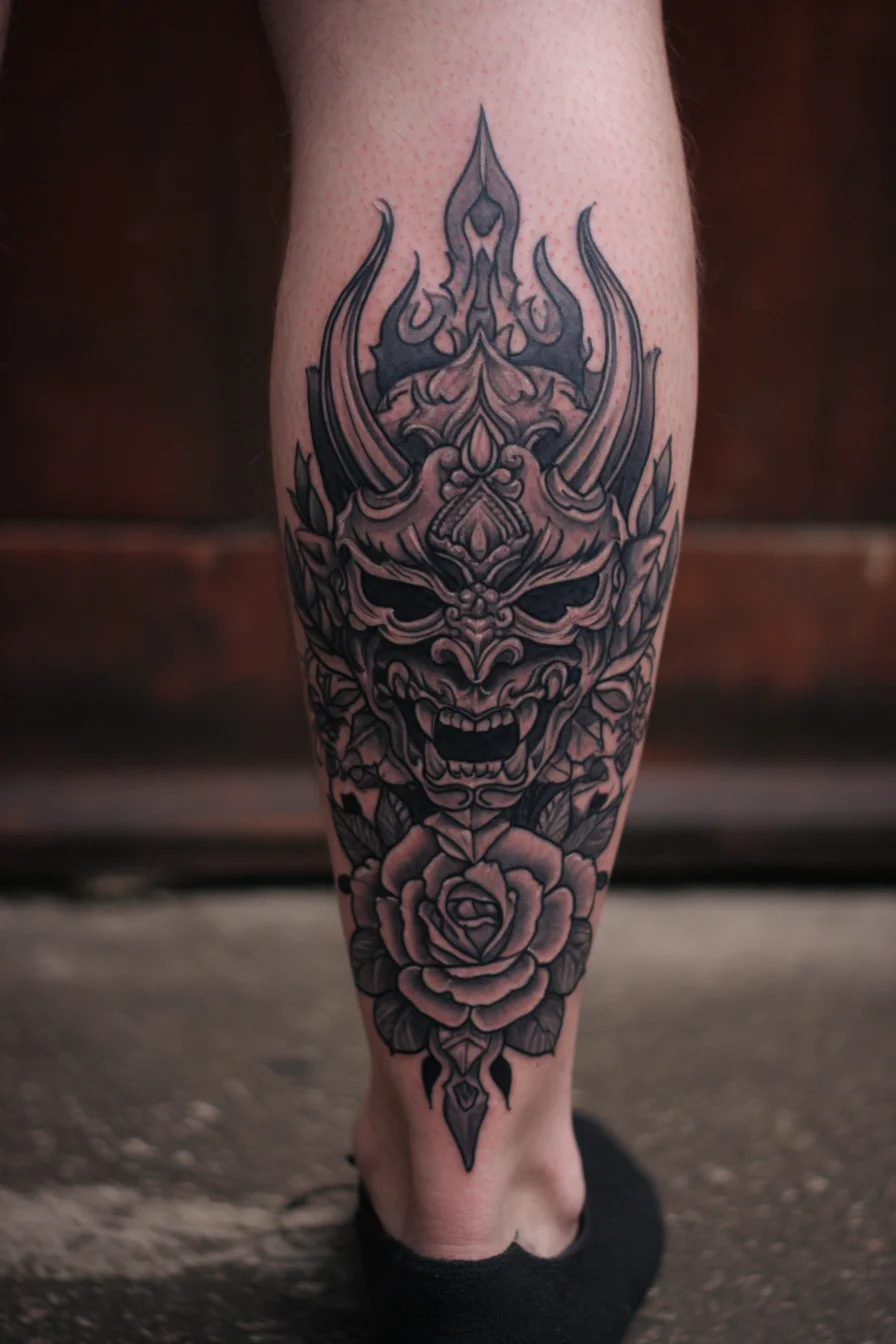
This black-and-gray Oni mask with a detailed rose combines traditional Japanese demon iconography and classic floral symbolism. The Oni conveys protection, controlled aggression, and inner strength while the rose adds contrast — vulnerability, honor or a memento motif — creating a masculine duality in one piece. Placement: ideal on the calf as shown, where a vertical composition wraps naturally and sits well within clothing choices; it also translates to the forearm sleeve, outer bicep, or thigh. Pain: calf tattooing is typically moderate — outer calf is tolerable for most clients, while the inner calf, shin bone, and ankle areas will feel noticeably more painful. Size: keep this design medium to large (roughly 15–25 cm / 6–10 in tall) so facial detail and petal shading remain crisp; scaling down risks losing fine linework and depth. Styling variations: convert to full color (red rose, gold accents), push neo-traditional bold lines, or soften with dotwork and ornamental backgrounds (waves, clouds, mandala). Practical notes: expect multiple sessions for saturation and deep shading, discuss symmetry and skin texture with your artist, and follow standard aftercare for optimal healing.
Realistic Norse Warrior Portrait Tattoo — Black & Grey Sleeve Idea
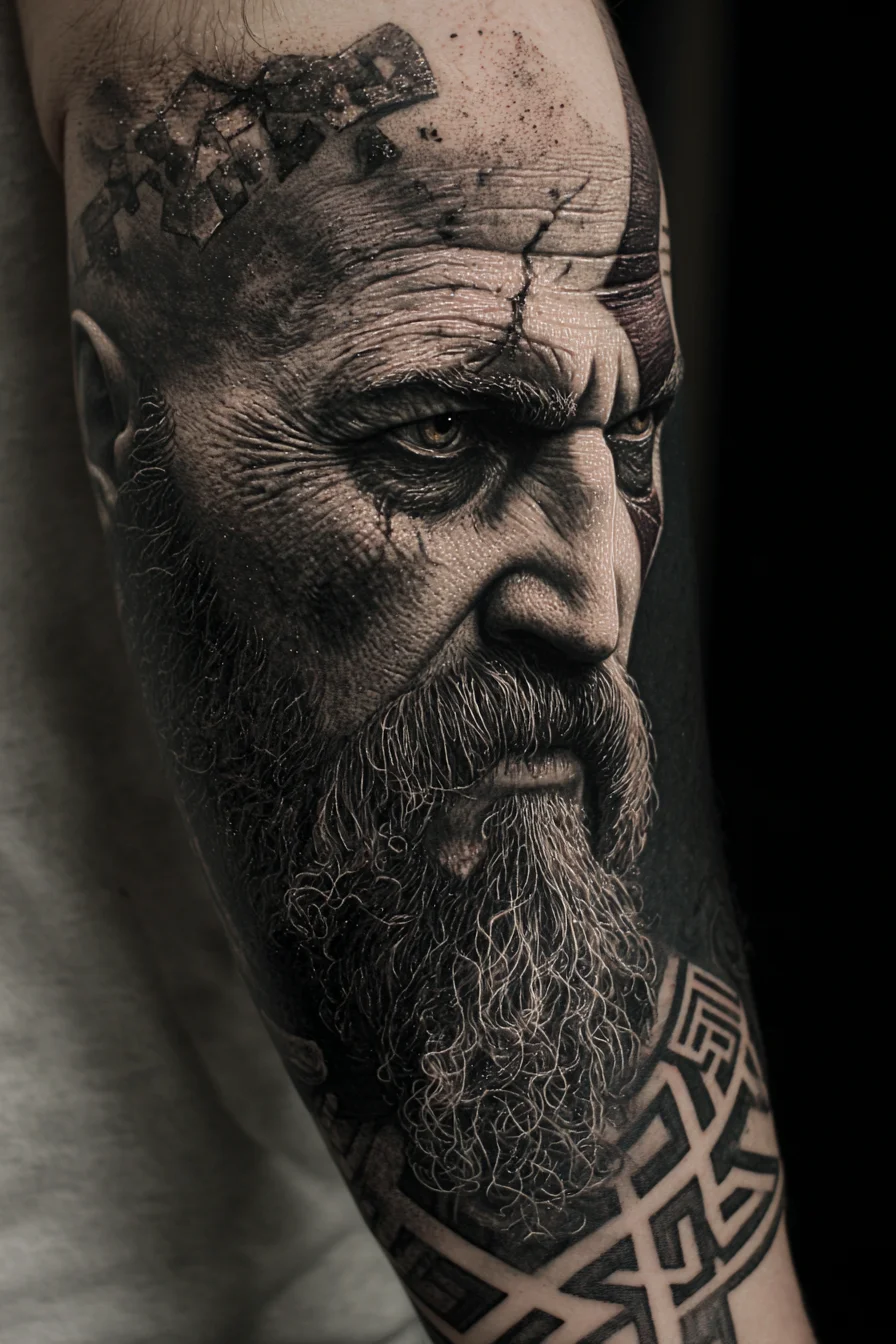
This hyper-realistic, black-and-grey warrior portrait reads as a statement piece about resilience, age and stoic strength — ideal for men who want a bold, narrative tattoo. The cracked skin, intense eyes and detailed beard convey battle-worn wisdom while the incorporated knotwork anchors the design in Norse-inspired symbolism. Placement suggestions: full or half sleeve for continuity and scale, outer upper arm for lower pain and visibility, or chest/back panels if you want a larger composition; forearm or thigh also work for vertical layouts. Pain expectations: outer arm and thigh are moderate and well-tolerated; inner bicep, ribs and over bone (elbow/shoulder blade) are significantly more painful. Size considerations: portraits require room — aim for at least 6–8 inches (15–20 cm) tall to preserve facial detail; larger sizes allow finer hair, pores and shading and usually need multiple sessions. Styling variations: pure black-and-grey realism, selective color accents (amber eyes, red war paint), dotwork or textured backgrounds, or integration with geometric/Norse knotwork borders. Consult a realism specialist, bring clear photo references, and plan touch-up sessions for longevity.
Crowned Lion Realism Tattoo — Black & Grey Calf or Forearm Piece
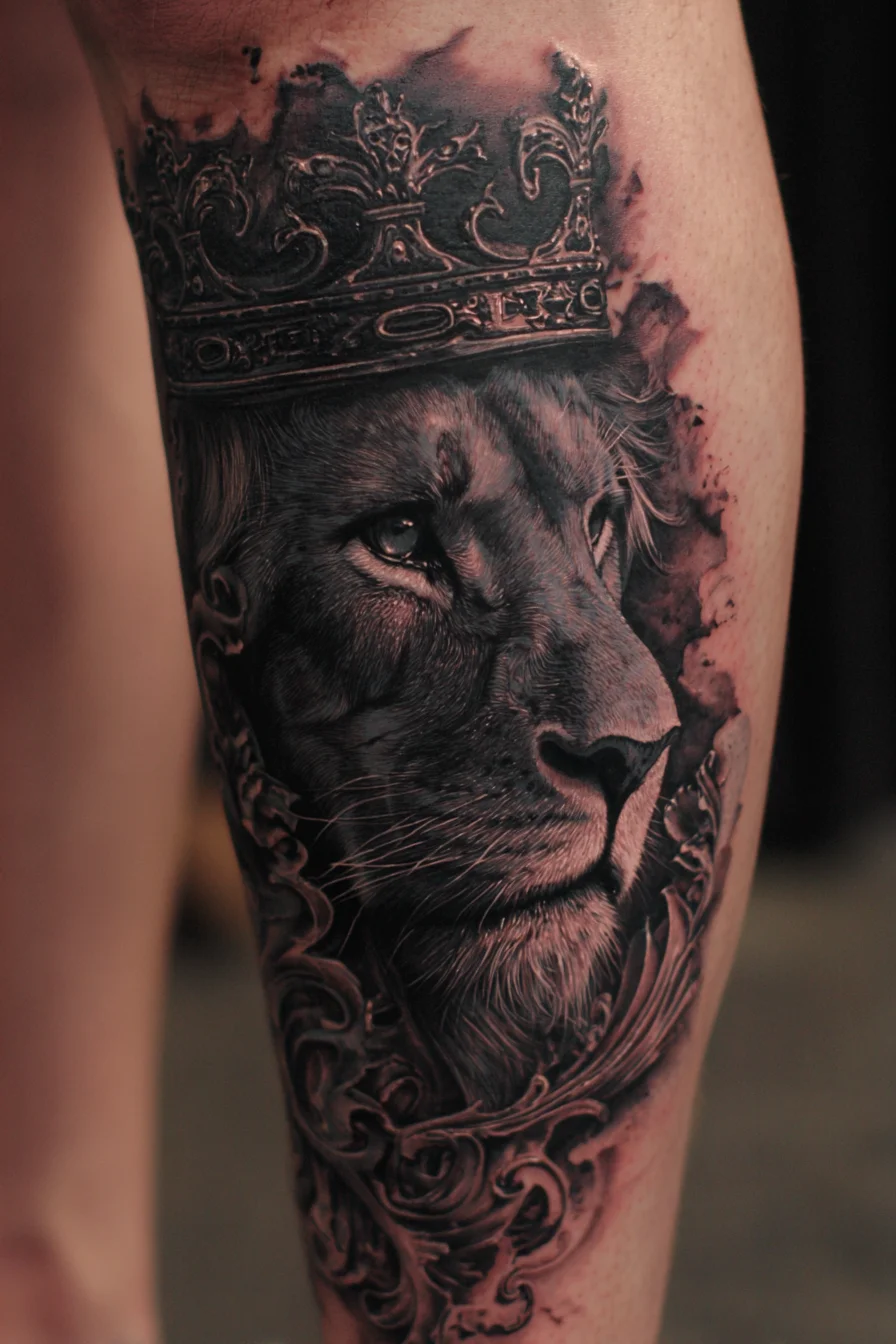
This crowned lion design reads as a statement of strength, leadership and quiet authority. The lifelike portrait and ornate crown combine classic symbolism (courage, royalty, protection) with a masculine, refined aesthetic. For placement, the outer calf — as shown — offers a long, flat canvas that preserves facial detail; other strong options are the outer forearm, shoulder/upper arm, thigh or chest depending on how visible you want it. Expect moderate pain overall: fleshy, muscular areas like the outer calf and upper arm are more tolerable, while inner limbs, ribs or near bone (shin, elbow) will be noticeably sharper. Size considerations are important for realism — plan a medium-to-large piece (roughly 6–12 inches) so the whiskers, eyes and crown filigree retain crisp detail. Realistic black & grey works best, but variations include selective color in the crown, subtle watercolor backgrounds, geometric framing, or neo-traditional shading to suit personal style. Talk with your artist about session length (often multiple 2–4 hour sessions), aftercare, and how scaling or contrast adjustments will affect long-term legibility and aging.
Realistic Skull with Sunglasses — Calf Black & Grey Tattoo
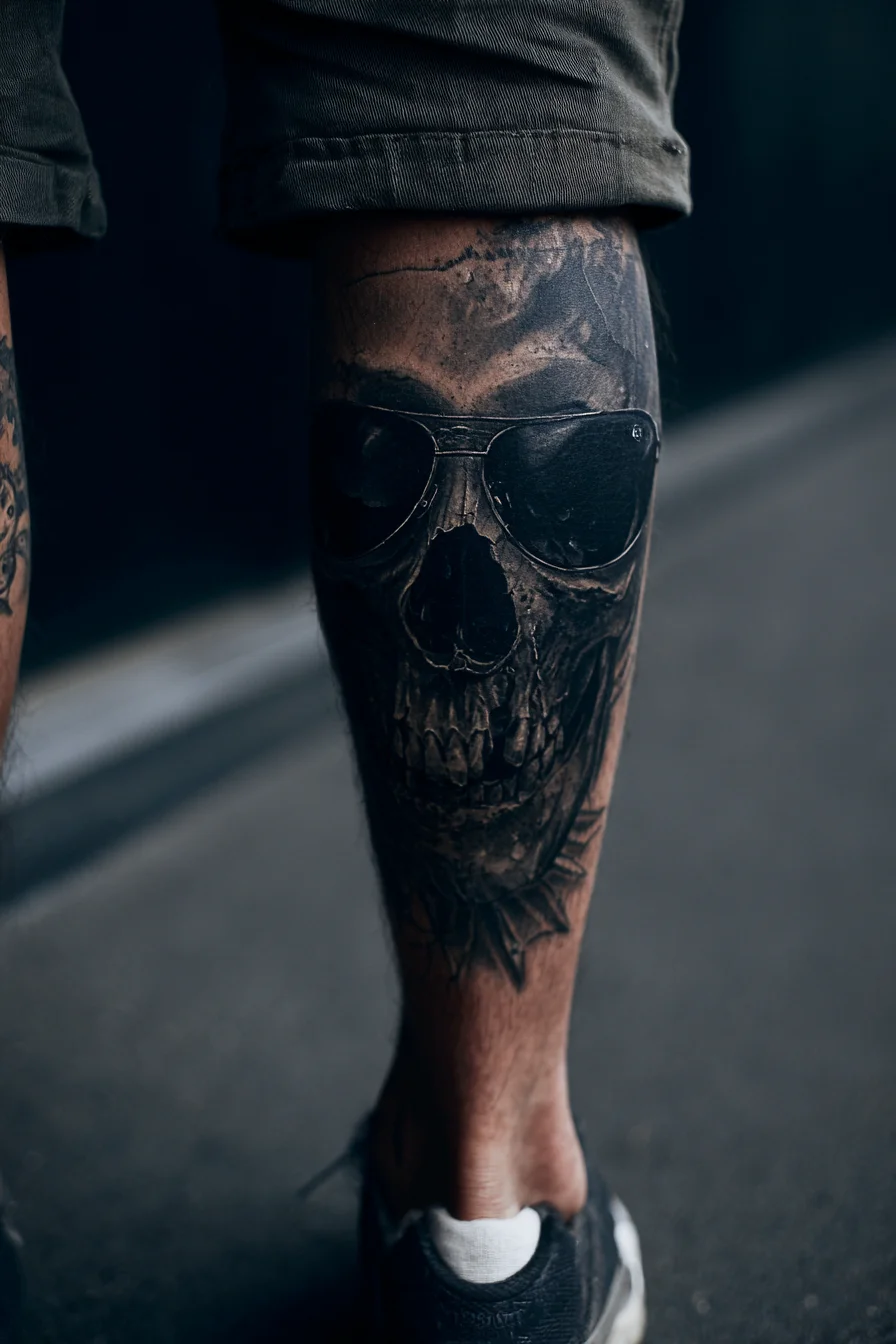
This black-and-grey realistic skull with aviator sunglasses reads bold and modern — a masculine statement about mortality, confidence, and a rebellious edge. The reflective shades add character and room for contrast, making it a strong portrait-style focal piece. Ideal placement is the outer calf as shown, which gives enough flat surface for detail and sits well with shorts or casual footwear; alternatives include the forearm, upper arm sleeve, or thigh for larger compositions. Expect moderate pain overall: the fleshy outer calf is one of the more tolerable leg locations, while the inner calf, shin, or ankle areas will be noticeably more sensitive. For realism to hold up over time, plan on a medium-to-large size — roughly 6–10 inches tall on the leg — so fine shading and teeth detail remain crisp. Styling variations include full black-and-grey realism, high-contrast dotwork backgrounds, selective color in the glasses’ lenses, or integrating geometric shapes, script, or florals for a personalized twist. Book a realism-specialist artist and discuss stencil placement and aftercare to preserve contrast and longevity.
Choosing a tattoo is a balance of aesthetics, meaning, and practicality. Start with one of these 11 ideas as inspiration, then book a consultation to tailor size, placement, and style to your anatomy and daily life. Prioritize artists whose portfolios show consistent line work and healed-photo examples in the style you want. Discuss ink type, color longevity, and expected touch-ups; darker, simpler pieces often age better if you lead an active lifestyle or work in conservative environments. Prepare for the session with hydration, rest, and a light meal; follow aftercare exactly to protect lines and color. Finally, treat the process as collaboration — the best results come when you bring references, trust the artist’s technical input, and allow small design adjustments for flow and longevity. If you want, send me which of the 11 ideas you like and I’ll suggest placement and artist-style pairings. — Hakan
